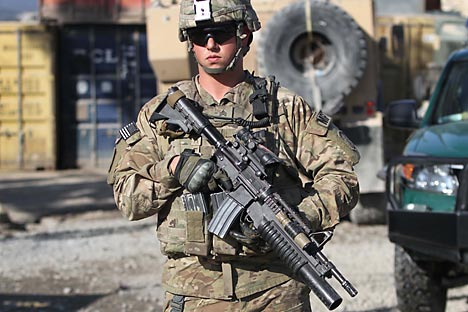“Post-American” Afghanistan is a chimera

Source: AP
Anniversaries are celebrated when there is reason to celebrate. The twelfth anniversary of the United States’ invasion of Afghanistan fell on the weekend and passed by unnoticed. True, there is hardly anything to celebrate. If the raison d’etre of the US’ 2001 invasion was to drive out the Taliban regime, the leitmotif of today’s “endgame” is to reconcile the Taliban. The intriguing character of the US’ intervention in Afghanistan stands out.
The objective of “nation-building” has been abandoned and no one wants to recall today that former US president George W. Bush once enthusiastically spoke about a Marshall Plan to rebuild Afghanistan on the pattern of post-war Germany. The only thing heard today is the fate of a Status of Forces Agreement [SOFA] that would pave the way for the establishment of nine American military bases in Afghanistan. The bases have been renovated, equipped and brought up to American standards and are ready for occupation as soon as SOFA [SOFA] becomes available.
This may seem the theatre of the absurd, which it is in many ways – US drives out the Taliban but fails to vanquish them and would now reconcile with them; Pentagon won’t undertake no more “combat missions” in Afghanistan but will keep thousands of troops nonetheless; the US and NATO forces operated under a UN mandate but the establishment of the American military bases will be a purely “bilateral” matter between Washington and Kabul. And the crowning irony is that the remaining sticking point holding up the conclusion of the SOFA is the Kabul’s insistence on its sovereign prerogative to have a say in the US’ military operations on Afghan soil, whereas Washington demands “immunity” for the American soldiers.
The US does not care to explain why it wants to establish the nine military bases in Afghanistan. Prima facie, it says it intends to ensure al-Qaeda won’t return to Afghanistan. Again, the old mantra is being revived – Taliban are an “Afghan phenomenon.” The Taliban’s links with the al-Qaeda, which was the primary reason for the US invasion of Afghanistan, is no more a matter of concern. Do those links still exist? Nobody knows. Again, if the Taliban indeed broke those links, how conclusive is the rupture? Can it be a tactical ploy? No one knows. All that we know is that the US is desperately keen to reconcile with the Taliban and accommodate then in Afghanistan’s power structure. In sum, the overriding concern in Washington is that the Taliban might otherwise target the US bases.
The sophistry in all this is patently obvious. And it raises questions about the US’ intentions in establishing such long-term military presence. For a start, it is one hundred percent certain that these proposed American bases will be put to use for carrying out electronic intelligence because of Afghanistan’s highly strategic location close to the vast hinterlands of China and Russia. Second, the US can be expected to deploy components of its missile defence system in these bases, thereby extending the arc that has come up to the Persian Gulf region so far. There are five states surrounding Afghanistan whose missile capabilities are on the American radar – Russia, China, India, Pakistan and Iran.
Lest we forget, even in the height of the Afghan insurgency, the US consistently spurned the Russian overtures for establishing a cooperative working relationship between the Collective Security Treaty Organization [CSTO] and the North Atlantic Treaty Organization [NATO]. The US’ obduracy was completely irrational on the face of it, because the western alliance needed all the help it could get from any friendly quarter to meet the Taliban challenge. The main factor has been that the US did not want to recognize the CSTO as a regional organization in a lead role in regional security in Central Asia, because the US hopes to incrementally project the NATO itself as the provider of security in Central Asia in line with the overall strategy to transform the western alliance as a global security organization bypassing the United Nations.
Suffice to say, the establishment of the American military bases in Afghanistan is principally aimed at the projection of US influence into Central Asia and the fight against the al-Qaeda becomes the alibi. The fact of the matter is that Central Asia is approaching a highly sensitive period of political transition. The leadership changes can be expected to bring in its wake huge uncertainties. Democratic transition or transfer of power to a successor regime is a highly complicated process anywhere and it is going to be even more so in the circumstances prevailing in the region. This is where the US intentions come under scrutiny. Without doubt, American exceptionalism makes it incumbent upon Washington to interfere in Central Asia’s political transition so as to usher in successor regimes that subscribe to western “values”. Against this backdrop, given the US’ track record of using Islamist groups as instruments of regional policies, Washington’s strange turnaround to accommodate the Taliban in mainstream Afghan political life has an ominous overtone. The US is holding out to Pakistan a massive aid package of $1.6 billion and another $300 million for security cooperation.
What emerges is that the Americans have no intentions to leave Afghanistan. In fact, it is doubtful if they ever had any such intentions. Any talk of a “post-American” Afghanistan is merely intended to lull the regional sensibility to lower the guard regarding the US’ long term intentions. The establishment of the US military bases will enable Washington to be proactive in regional politics and liberated from day-to-day preoccupations of “combat missions” in Afghanistan, the US strategic presence can be put to use more effectively in the Central and South Asian region as part of the US rebalance.
All rights reserved by Rossiyskaya Gazeta.
Subscribe
to our newsletter!
Get the week's best stories straight to your inbox